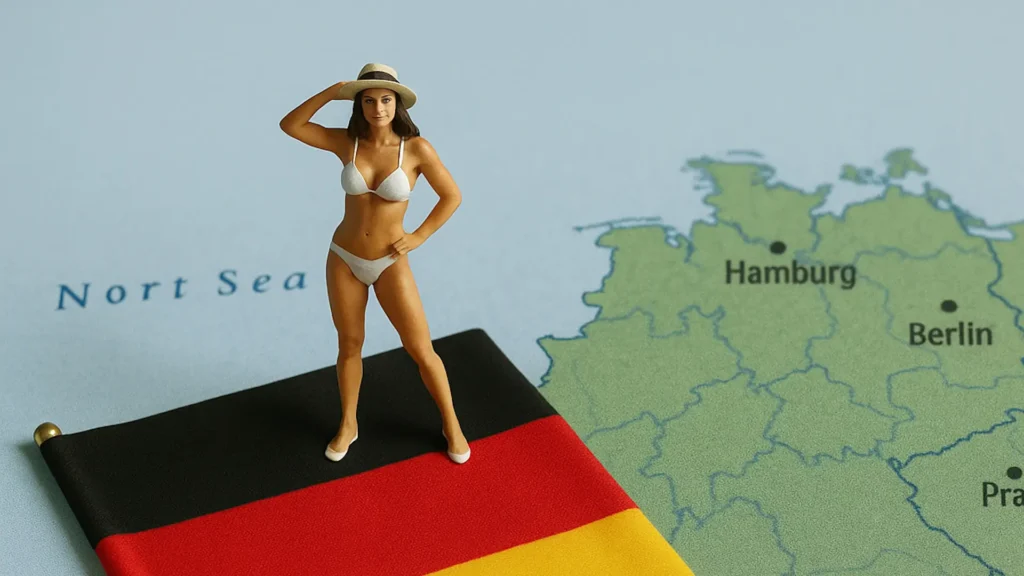Former Duisburg Police President Elke Bartels has once again called for Germany to adopt the Nordic Model of prostitution laws to fight human trafficking and forced prostitution. In an interview with German newspaper taz, Bartels continued pushing for stricter rules in the sex industry, something she has been doing since her time as Duisburg’s police chief.
Previously we wrote
In our August 2023 article, Women are completely vulnerable: the reality of prostitution and human trafficking in Germany, we shared Bartels’ concerns about women trapped in prostitution.
She pointed out how Duisburg had become a hotspot for gangs and organized crime with its large brothel area and how the city had seen many Eastern European women working in the Vulkankarree red-light district.
We also covered her troubling stories about clan crime controlling brothels, including Nigerian women controlled through voodoo threats.
Bartels stressed that many women in certain ethnic groups are born into situations where they have no rights and depend completely on their clans.
The current situation
Now, almost two years later, Bartels still holds the same views. She calls Germany Europe’s brothel, where women are easily forced into prostitution. She believes that using the Nordic Model, which makes it illegal to buy sex but not to sell it, would be the best way to fight forced prostitution.
When asked if these restrictions would just push prostitution underground, Bartels said that the hidden sector is already so big, especially for forced prostitution, that it couldn’t get any bigger. The main problem, she says, is that police can’t investigate this hidden world under current laws.
She explained that right now, police can’t check brothels without a reason, but they could if buying sex were illegal. This shows how the 2002 loosening of prostitution laws has made it harder for police to do their job.
Why the nordic model is bad
Despite Bartels’ support, the Nordic Model is very controversial. Many sex worker groups and researchers say it creates more problems than it solves. Critics point to several issues with this approach:
For sex workers
The Nordic Model pushes the sex industry underground, where workers have less protection and face more dangers. When sex work happens in the shadows, sex workers can’t ask police for help without getting their clients in trouble, which leaves them open to abuse and violence.
The stigma around sex work under this model can lead to social rejection, discrimination, and isolation. This makes it harder for sex workers to get social services, housing, and other jobs. This goes against the model’s goal of helping sex workers, as it creates big obstacles in their lives.
Health risks go up, as the criminalization of clients pushes sex work into riskier places where health and safety rules aren’t followed. Sex workers in these places have less access to health services, including STD testing, and may be afraid to seek medical help when needed. Read our full article here: Top 10 reasons why the Nordic Model is bad for sex workers

For men and clients
Critics say the Nordic Model unfairly punishes men who buy sex, possibly hurting their families, jobs, and social lives. The model reinforces negative stereotypes about clients, portraying them as exploitative and immoral without considering the various reasons men might seek sexual services.
Making it illegal to buy sex makes clients vulnerable to blackmail. Knowing they’re doing something illegal, clients may be targeted by people who threaten to expose them unless they pay more money.
Men who are criminalized for buying sex have limited access to legal help and may be afraid to seek medical help for sexual health issues due to fear of exposure and legal consequences. This reluctance to seek help can lead to the spread of STDs in the wider community. Read all the reasons here: Top 10 reasons why the Nordic Prostitution Model is bad for men
For society as a whole
The Nordic Model puts a heavy burden on police, taking resources away from more serious crimes. It also results in lost tax money, as legal sex workers who previously paid taxes may work illegally to avoid detection.
The closing of legal sex businesses can lead to more unemployment and strengthen criminal networks, as the demand for sexual services doesn’t disappear but instead moves to the black market. Criminal groups step in to fill this gap, potentially increasing their power and influence.
Public safety may be worse as illegal operations are more likely to involve violence and exploitation.
The model has also been criticized for failing to effectively address the root causes of exploitation, as it forces those in the industry to operate illegally where they have less protection.
Some research suggests that countries using the Nordic Model, like Sweden, have seen increases in reported cases of sexual violence. Sweden has one of the highest reported rape rates in Europe, though this statistic must be interpreted carefully as it may also reflect differences in reporting practices and legal definitions. Read our full article here: Top 10 reasons why the Nordic Prostitution Model is bad for society
Ongoing debate
The debate continues as Germany deals with the consequences of its liberal prostitution laws, which were meant to improve conditions for sex workers when introduced in 2002 but have been criticized for enabling human trafficking and exploitation.
Bartels’ consistent advocacy over the years shows the ongoing nature of these problems and the urgent need to address the vulnerabilities faced by women in prostitution, particularly those forced into the industry through coercion, poverty, or clan control.
However, as the controversy surrounding the Nordic Model shows, finding effective solutions to combat forced prostitution while respecting the rights and safety of sex workers remains a complex challenge with no easy answers.

